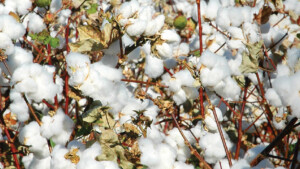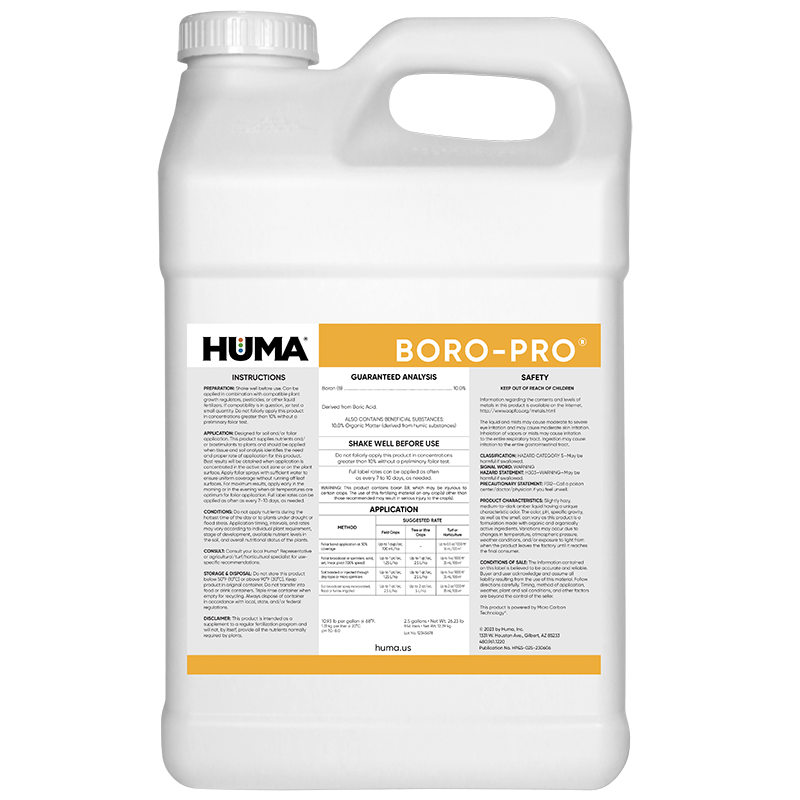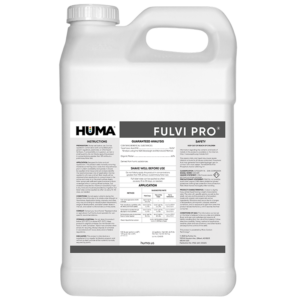BORO-PRO
Benefits of Use:
- Supplies boron nutrition necessary for metabolic activity, proper growth, and maturation
- Enhances pollen viability and pollination in flowering crops
- Improves quality of crop
- Is required for cell division and normal tissue differentiation and maturation
- Functions with calcium to form an “intercellular cement” to maintain plant structuralintegrity
- Improves protein metabolism and reduces nitrate accumulation in young leaves
- Improves sugar transport in plants
Deficiency Symptoms—When to Apply:
- Reduced flowering or improper pollination
- Stubby stem or root growth; weakened cell walls that allow crop lodging
- Thickened, curled, wilted, and chlorotic leaves
- Symptoms of calcium deficiency may appear
- ALFALFA: yellow-reddish leaves in new growth, CORN: pollen tube failure, COTTON: rosette, NUT CROPS: decreased yields in otherwise-healthy trees
To add zinc to a boron application, Z-Max® can be mixed with Boro-Pro® when both are properly diluted.
FAQs
Related Videos
Huma® Micronutrients and Secondary Macronutrients
Huma liquid micronutrient and secondary macronutrient fertilizers with Micro Carbon Technology (MCT) are extremely efficient. MCT improves nutrient uptake so you can get the most out of your crops. Deliver micronutrients and secondary macronutrients exactly
Learn More
Related Products
Related Case Studies

Huma® OM Liquid HA 16 With Micro Carbon Technology® Improves Spring Wheat Yield With 60% Increased ROI
Background Humic substances have been shown to improve crop yield. Solid and liquid forms of humic substances with high levels of organic acids can be produced by incorporating Micro Carbon Technology®. Some are suitable for conventional and others for organic farming. Huma® OM Liquid HA 16, OMRI-Listed for organic farming, is a liquid form of

Huma® Zap® Increases Cotton Lint Yield by 125.8 lb/A, With 67% ROI
Background Application of Zap® to soils in combination with other Huma® fertilizers at various locations previously resulted in crops with improved plant growth and higher yields. Applying Zap® with grower standard products or as a single product application to soil and plants could also impact results. Objective The focus of this study was to observe

Huma® Fertilizer Products Increase Cucumber Yields at ROI of 113%
Objective The purpose of this research project was to evaluate how Huma® liquid fertilizer products with Micro Carbon Technology® affect cucumber yield when compared with a control program of grower’s standard fertilizer. Materials & Methods This study was conducted at the Southeast Ag Research facilities in Chula, Ga. The experiment was conducted with four replicates.
Related Blog Posts

This Week in Ag #48
The popular TV series Yellowstone, along with the western lifestyle craze, has certainly romanticized ranching. It seems like everyone wants to be a rancher, until there’s real-world ranching stuff to do. This week’s bone-chilling Midwestern weather brings back memories. Notice I didn’t say fond memories. When you have livestock, they require care every day. Utility tractors

Jason Garcia on Commercial Vegetable Growing with Huma Gro®
With Larry Cooper Vegetable growers in Central Florida are preparing to get their beds ready for planting, so here’s my guide to how Huma Gro® can help growers get their best vegetable crops ever. Bed Preparation It’s become a pretty standard practice for Florida vegetable growers to fumigate their fields, then put down plastic and

Save 25% on Phosphorus Fertilizer with Huma SUPER PHOS®
Phosphorus fertilizer prices are at record highs, but Huma Super Phos® offers a smarter solution. With Micro Carbon Technology®, Super Phos® delivers higher nutrient efficiency while saving growers up to 25% per pound of P₂O₅ compared to DAP or MAP.








